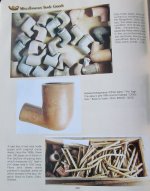Bruce R
Bronze Member
- Mar 18, 2016
- 2,271
- 2,095
- Detector(s) used
- Whites coinmaster
- Primary Interest:
- Metal Detecting
I found this in a field bordering a large stream where I've always found arrowheads, it's some kind of ceramic with a brown glaze over the whole thing. If you can see in the photos the piece is glazed inside as well, also, the "stem" end that looks broken off is glazed, so it must have been made that way. Anyone have any ideas  I know the Indians used tobacco, but I thought they used those "peace pipes" too much TV for me I guess.View attachment 1303820View attachment 1303822View attachment 1303823View attachment 1303824View attachment 1303825View attachment 1303826
I know the Indians used tobacco, but I thought they used those "peace pipes" too much TV for me I guess.View attachment 1303820View attachment 1303822View attachment 1303823View attachment 1303824View attachment 1303825View attachment 1303826
 I know the Indians used tobacco, but I thought they used those "peace pipes" too much TV for me I guess.View attachment 1303820View attachment 1303822View attachment 1303823View attachment 1303824View attachment 1303825View attachment 1303826
I know the Indians used tobacco, but I thought they used those "peace pipes" too much TV for me I guess.View attachment 1303820View attachment 1303822View attachment 1303823View attachment 1303824View attachment 1303825View attachment 1303826





